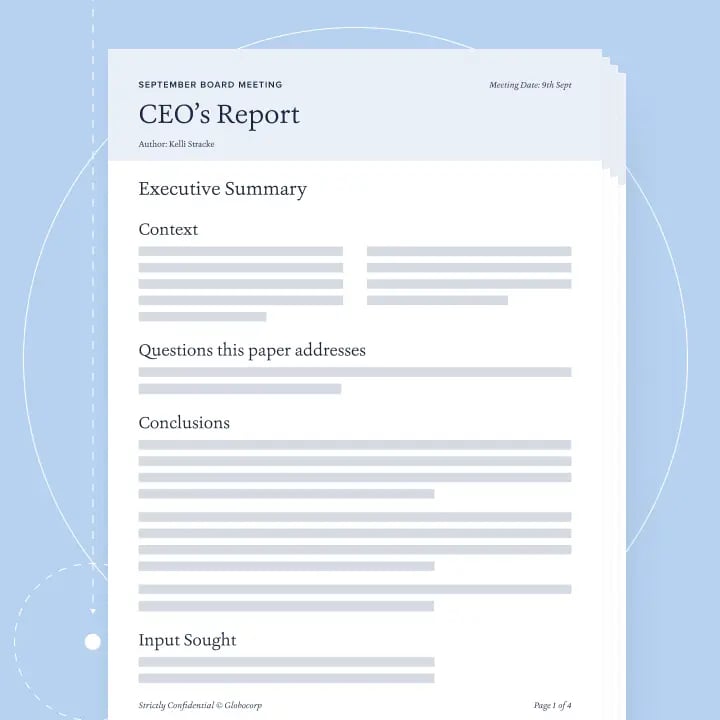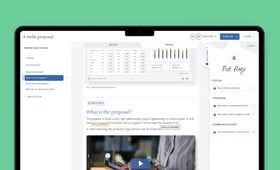Board Intelligence and the Chartered Governance Institute UK & Ireland have been researching company board packs for five years. We’ve asked directors and governance professionals to assess their strengths and weaknesses, and observed trends in the content and quality of board reports.
Over that time, board packs have become longer but also less insightful. Half of board members compare their board pack’s key messages to “needles in a haystack.” Bloated board materials make an already challenging job even harder, obscuring insight, derailing discussions, and delaying important decisions.
Information overload is one way of befuddling the board.
~ Martha Lane Fox, Chair, Open University and WeTransfer; President, British Chambers of Commerce
Many governance professionals courageously take it upon themselves to fix the problem, painstakingly reviewing and editing individual board papers before distributing them. But making those edits is costly, distracting, and ultimately unsustainable.
It’s also ineffective, relieving the symptoms without addressing the root cause of the problem: that management doesn’t have the right tools for the job.
So, what can you do to improve your organization’s board papers without having to carry the burden yourself?
Do templates and training improve board paper quality?
Most governance teams will inevitably put down the red pen and try to tackle their board reporting problem by rolling out training or report templates. But in 2023, just 27% of those who provided in-house training rated their board pack as “Good” or “Excellent.” Meanwhile, 81% of the organizations using templates for their board papers classed their packs as “Poor” or “Weak.”
This is hardly a ringing endorsement, but it’s not a complete surprise. Research shows that we forget approximately 75% of new information within six days if it’s not appropriately applied. So, although training can encourage management to engage with the principles of effective report writing, it’s unlikely to change how they work day-to-day. This is especially true if the training relates to something they do only once a month. It’s also challenging to roll out and sustain the impact when you’re working with large teams of report writers and a cast that frequently changes.
What about templates? Unlike training, they’re a relatively low-cost option and easy to distribute across a large team. They can help report writers use a certain font, follow a specific layout, or include an executive summary, all of which can help make the rough edges of the board pack smoother. But they can’t force management to write concisely or answer all the questions the board wants to know about. And they’ll only have a big impact on the board pack if every writer uses them as the governance team intended.
Typically, around 20% embrace training and change their behavior, another 20% don’t engage with it at all, and the rest, despite being well-intentioned, will adopt some of the advice but quickly forget most of it.
~ Anna Scholes, Senior Manager, Board Intelligence
How do you solve the board pack problem in a lasting way?
To deliver a better board pack that stands the test of time, scale, and changing personnel, you must first be clear on what a good board paper looks like.
We’ve found that an effective board report is loaded with critical thinking that’s communicated with impact and focused on what matters most to the organization. Let's expand on this:
- Critical thinking is needed to surface insights, generate actionable ideas, and produce robust plans that the board can support.
- Great communication expresses management’s insights and ideas to the board, giving it the opportunity to test, refine, and act on them.
- Focus means these efforts have an impact because they’re trained on the organization’s most pressing issues and exciting opportunities.

Three pillars to load board reports with sharp thinking and convert insight into action.
We look for these capabilities when we review board papers. They’re at the center of our methodology, the Question-Driven Insight (QDI) Principle. Any board pack intervention should aim to embed these principles.
You’ll know they’re working when you’re confident that your report writers are thinking deeply about their subject matter and surfacing insights that the board can act on, every time they write a paper.
We’ve adopted the QDI Principle to help us think through the questions we should be answering and the storytelling behind our reports.
~ Rachael Turk, Group Head of Strategy, Beazley (FTSE 100 insurer) — watch the video
How can technology improve board papers?
t’s one thing to have a methodology that helps management think well. Getting them to use it consistently is another matter. As anyone who’s ever tried (and failed) to adopt a New Year’s resolution will know, old habits can be hard to get rid of.
To embed best practice, you must make it easy for writers to follow the new methodology by integrating it into their ways of working. This is where the right technology can be transformative. Tech can fill in the gaps left by training and templates, nudging report writers to follow best practice and embedding new behaviors as simple step-by-step processes.
This is rooted in the Japanese concept of poka-yoke (“mistake-proofing”), where you design a product or process so that it’s difficult to get things wrong. The term originated on the manufacturing floor in the 1960s, and today, it’s seen everywhere, from lawnmower safety bars to filing cabinets that won’t let you open more than one drawer at a time.
The concept also extends to modern software tools, which, fuelled by recent advancements in AI, can set you on the right path and gently guide you back when you stray off it.
Lucia, Board Intelligence’s AI-powered management reporting platform, does just this. It acts as an always-on-call critical friend and editor, using smart nudges to help managers write better, think in a deep and structured way about the topics at hand, and focus their efforts on what matters most to the organization.
For example, Lucia will tell writers when they’ve paid more attention to the opportunities than the risks, forgotten to answer key questions, or gotten stuck on backward-looking information. It can also warn writers when they’re being overly wordy, and it will point out if they forget to put the bottom line up front.
Lucia has really helped me write meaningful, well-structured reports. The AI guides me to think about what I want to say and the key messages to get across.
~ Catherine Schlieben, Group Head of Performance & Development, National Grid
Real-time nudges like these ensure that papers hit the mark and set the stage for productive board meetings, long before the governance team starts pulling the pack together.
With Lucia helping management consistently apply best practices, directors get the information they need. Governance teams can finally put down the red pen and refocus their energy on adding value.




